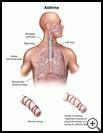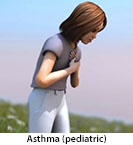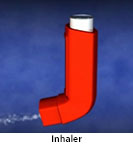
Asthma: Smoking and Your Child
________________________________________________________________________
KEY POINTS
- Asthma is a chronic lung disease that causes coughing, wheezing, shortness of breath, and chest tightness.
- Children with asthma who live in a household with a smoker have more breathing problems, need to take more medicines, and have more emergency room visits than children who live in smoke-free homes.
- Limiting exposure to these triggers can help prevent problems for your child.
________________________________________________________________________
How does tobacco smoke affect children with asthma?
Asthma is a long-lasting (chronic) lung disease. It causes wheezing, coughing, shortness of breath, and chest tightness.
Asthma symptoms are caused by two different problems in the airways.
- One problem is that the muscles in the airways tighten up, which causes chest tightness and wheezing.
- The other problem is swelling, irritation and too much mucus in the airways.
Tobacco smoke irritates and damages the airways in several ways. Smoke is made up of chemicals and very small pieces of ash that stay in the air long after the cigarette, pipe, or cigar is out. When a child with asthma breathes in these airborne chemicals and ash, it irritates the lining of the airways. This causes the muscles around the airways to squeeze tight, making it hard for the child to breathe.
Breathing secondhand smoke, also called passive smoking, is also harmful to the lungs. Children who breathe secondhand smoke often have symptoms such as coughing, wheezing and a tight feeling in the chest. Even the smell of smoke on clothes can trigger asthma symptoms in a child with sensitive airways. Children with asthma should not spend any time in places where there is smoke. No one should smoke in the home, and no one should smoke in a car that a child with asthma rides in.
Children with asthma who live in a household with a smoker have more breathing problems, need to take more medicines, and have more emergency room visits than children who live in smoke-free homes. Children who live in a household with a smoker are also less likely to outgrow their asthma.
E-cigarettes also cause problems. They do not produce water vapor. They produce very fine particles of chemicals that may be more concentrated than chemicals in tobacco cigarettes. These chemicals can irritate your child’s lungs and worsen breathing problems, including asthma. The vapor from e-cigarettes may also be harmful to people who are near someone who is vaping, similar to secondhand smoke. For this reason, many cities have passed laws against vaping in public places.
If you or your child smoke or use e-cigarettes, it is very important to quit smoking or vaping. Talk to your healthcare provider about ways to quit.
What will help me stop smoking?
The American Lung Association gives the following tips:
- Set a date for quitting.
- Remove cigarettes, ashtrays, matches, and lighters from your home, workplace, and car.
- Keep a supply of low-calorie snacks handy.
- Spend more time in places that don't allow smoking.
- Tell everyone you're going to stop smoking.
- Plan what you'll do instead of smoking.
- Call a friend if you need help.
- Think about using nicotine replacement gum or patches. The nicotine gum or patches help you cut your craving for nicotine. You can also ask your healthcare provider for a prescription medicine, such as Zyban, to help you quit.
For more information, contact:
- American Lung Association
800-548-8252
http://www.lung.org
Last modified: 2017-07-10
Last reviewed: 2017-06-26



